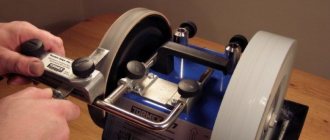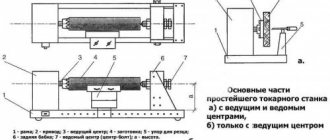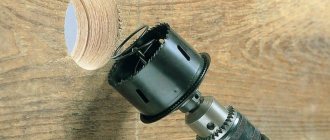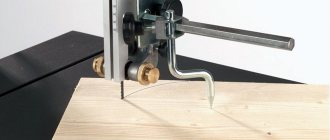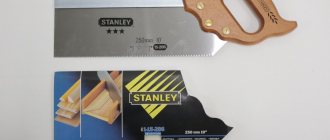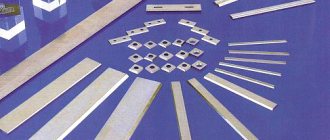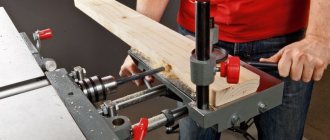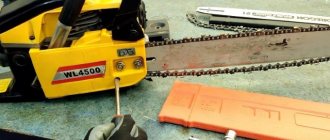Any cutting tool tends to become dull during use. This also applies to carbide saw blades, which must be sharpened regularly in order for wood to be sawed quickly and efficiently.
The easiest way to sharpen teeth on a circular saw is to use a regular file. But when working with your own hands, to bring the cutting tool into working condition, many difficulties arise that only a good specialist with sufficient experience can cope with. It is much easier, faster and more efficient to use a homemade machine for sharpening circular saws or a sharpening machine for circular knives for this operation.
Machine for sharpening circular saws Monolit TD1-600
If you have a homemade electric sharpening machine for circular saws, regardless of whether it is a factory tool or a homemade one, you should know the basic principles of using such equipment. Especially when there is a need to sharpen the teeth of saw blades that have different geometries and sharpening angles.
Machine
A machine for sharpening circular saws is not just one device. This can be called a large group of equipment and tools for special purposes.
– Automatic. The sharpening process is completely mechanized and there is no need for human participation. Such devices are used for production purposes.
- Manual. These can be any devices and tools for sharpening by hand. The productivity of such equipment is much lower than automatic machines. This type has found application in handicraft workshops for domestic needs.
Equipment of this kind is available for sale in a wide range; devices may differ in function, power and price. A manual machine for sharpening circular saws, the price of which will be much lower (about 20 thousand rubles), can be made independently. The equipment consists of dense and hard alloy plates that serve as cutters.
Plates for them are made from alloys of various compositions.
Differences in insert teeth
The tooth of hard alloys has four main planes for work: front, back and lateral (auxiliary). When the planes intersect with each other, cutting edges are formed: the main one and a pair of auxiliary ones.
The shape of the teeth is as follows:
- Direct. The use of this form will be justified when longitudinal cutting is required, which is quick in time and not required in quality.
– Oblique or beveled. The angle of inclination of the rear shape can be right or left, they alternate with each other. This configuration is the most common. Sharpening blades of different sizes are used to work with different materials in any direction.
– Trapezoidal. This tooth dulls its edges more slowly than a beveled tooth. Alternate it with the straight one. In this case, the rough cut was a longer trapezoidal cut, and the finishing cut was a short straight cut.
– Conical. This form of teeth performs a rough cut on the lower edge of the boards, while protecting the upper edge from chipping. Basically, the front edge of such an element is flat. But if you make it concave, then it is possible to use this device for cross cutting in a finishing version.
Read also: 18v power supply for a screwdriver
Main stages of work
At the next stage, the author screws two bars to the base (these will be guides), placing them along the edges of the board parallel to each other.
From a piece of board we make a carriage that will move back and forth between the guides.
To make the carriage slide better on the base, you can lubricate its bottom and sides with grease.
We drill a hole in the carriage and install part of the gearbox housing with a shaft (from an old angle grinder). We screw two wooden slats to the guides, which will fix the carriage on top.
Next, install the angle grinder and tighten the sheet metal clamp with bolts.
We put a saw blade on the gearbox shaft of the angle grinder. We fix it with a clamping nut. After this, you can start sharpening the teeth.
The detailed process of making a homemade sharpening machine for saw blades can be seen in the video below. This idea belongs to the author of the YouTube channel ideas corner.
Source
Sharpening angles
The fundamental angles are those determined by the shape of the teeth. These are front and rear, as well as bevel along the front and rear planes.
For longitudinal cutting of the front angle, it is recommended to set the degree in the range from 15 to 25. For transverse cutting - 5-10 degrees. For universal saws of both sections, it is more correct to choose the average value of 15 degrees.
The size of the angle is also determined by the hardness of the cutting material.
You can buy a machine for sharpening carbide circular saws at a cost of 15,000 rubles. You can also shell out for more expensive devices. For example, PP-480Z will cost its owner 280,000 rubles. Prices vary and depend on the purpose of the device, its functions, power and performance. For a small workshop or home use, you can purchase a JMY8-70 circular saw sharpening machine. Its cost is within 18,000 rubles.
Techniques and rules for turning saw blades on wood
To restore the condition of the saw teeth, it is necessary to sharpen their edges with high quality. In this case, it is necessary to take into account their uneven wear. Mostly the front part becomes dull because a lot of the load falls on it.
Then you need to study in detail the manufacturer’s instructions for operating the machine.
It is important to first prepare it (install it on a flat surface, connect and configure it correctly). Then you can proceed to turning the discs, and the technology will depend on the type of teeth and the area being sharpened
Sharpening a straight tooth along the front plane
The front part of the teeth of the saw blades is sharpened in this way:
- The disc to be sharpened is placed on the mandrel, after which it is clamped with a conical sleeve and nut.
- Then it is adjusted horizontally using a pendulum protractor. In this case, the bevel angle of the front plane should be equal to 0°.
- By rotating the screw, the mandrel with the wheel moves horizontally to precisely adjust the front sharpening angle, as a result, the front part of the tooth should be pressed tightly against the grinding wheel.
- The first tooth to be sharpened is marked with a marker.
- The electric motor is turned on, after which the front part of the tooth is sharpened - to do this, it is pressed against the abrasive wheel several times with translational movements and released. Moreover, due to the pressing force, the thickness of the metal removed from the tooth is regulated.
- After sharpening one tooth, the saw blade is removed from the grinding wheel, then it is rotated along the axis by one tooth for further sharpening.
- This procedure is repeated until the disc being sharpened rotates to the location previously marked with a marker.
Sharpening a front beveled tooth
To do this, the disk must be installed at an angle - at the bevel angle of the front part of the teeth. Most often it is +8°. Then the 1st tooth is also marked with a marker and every 2nd tooth is sharpened sequentially. Next, the position of the disk is changed and a negative sharpening angle of -8° is set. Then every second tooth of the disc is sharpened again.
During turning, it is necessary to maintain a uniform bevel for each cutting segment. If there is a large error, it is necessary to reinstall the disc being sharpened so that the teeth on it are of the same shape. In this case, it is necessary to periodically make control measurements.
Sharpening teeth on the back plane
One of the important stages of turning circular saw blades is processing the back of the teeth. To do this, they are installed so that the back of the teeth is located in the same plane with the working surface of the grinding wheel and is in normal contact with it.
It is also necessary to take into account the rotation speed of the working tool. On equipment with manual adjustment, it is necessary to eliminate the possible overheating of the edges of the teeth being sharpened. In addition, you need to make sure that the circle does not remove a lot of metal from the teeth. Changing the shape of one or more cutting elements will negatively affect the quality of wood processing.
Sharpening rules
The main wear of saw teeth occurs on the top edge, which is directly involved in cutting. Its rounding can be 0.3 mm. The central face changes earlier than the others.
– We must not allow significant wear on the saw. The edge can be rounded no higher than 0.2 mm. It is more difficult to sharpen a saw that is duller than this value. This will take longer than for a tool with normal wear. The degree of wear is determined either by the type of cut or by the teeth.
– We must not forget about the maximum possible number of sharpenings performed. This value is in the range of 30-35 times. To achieve this result, both surfaces are treated at once.
– Before starting work, you should clean the working disk from dirt, and also measure the angles of inclination. Preparation for sharpening is carried out from the front of the tooth. The layer of metal that can be removed is 0.20 mm.
– If abrasive diamond wheels are used for sharpening, they must be cooled with a liquid of a special composition (coolant). For better quality and lower specific gravity, it is better to choose a high-grit wheel.
– Jagged edges and irregularities should not be allowed, even if this is a homemade machine for sharpening circular saws. They can lead to untimely exit from work and crumbling of the metal.
How to know when it's time to sharpen a disc
Cutting discs used for processing wood and wood-based materials experience wear and tear over time, reducing their productivity. To restore the effectiveness of the cutting tool, you will need to sharpen the teeth. You can find out that the teeth on the disk need to be sharpened by the following factors:
- To cut wood, it is necessary to apply force to press the tool against the workpiece being cut.
- There is smoke coming from under the protective casing.
- The protective casing becomes overheated
- There are signs of a burning smell. This means that the teeth do not saw the wood, but cut it
Using a faulty attachment on a power tool leads to a decrease in work productivity, and also increases the likelihood of early failure of the power tool and the attachment itself. A decrease in performance increases the load on the electric motor, which eventually begins to overheat and fails.
This is interesting!
It is irrational to work with a dull disk, since in addition to increasing the load on the power tool, the work time for sawing workpieces increases.
artisanal
Sharpening it yourself won’t be too difficult. Especially if you have the necessary equipment. And if not, then you can make it yourself. You can make a machine for sharpening circular saws, the price of which will only please you, from simple parts. To do this you will need the following basic elements:
The circle is fixed on the engine, the disk blade is on the caliper, the screws will ensure the movement of the workpiece along the axis of the circle, which will provide the desired angle.
The main task for such an element as a machine for sharpening circular saws is to fix them in the required position relative to the circle. This is necessary to accurately maintain the angles; this can be provided by a stand mounted on the machine frame in the same plane as the circle.
When placing the disk on a stand, the teeth must be perpendicular to the plane of the sawing machine.
Step by step instructions
Circular saws are sharpened from the underside plane facing the workpiece being cut. If you wish, you can sharpen the saw by first removing it from the machine, although this is not necessary. If you decide to sharpen in a machine, you should first unplug the machine so that it does not accidentally start. Secure the blade stationary by pressing wooden blocks against the saw on both sides. Use a marker to mark the cutter you want to start sharpening with.
It is important to remember how many file strokes you have made, since all subsequent cutters must be sharpened exactly like the first. Strive to make the surface of the incisors as smooth as possible. Remaining nicks will cause rapid tool wear. At the end of the work, plug the machine into a socket and check the quality of sharpening by using an unnecessary block for sawing
Loud noise and uneven operation indicate that the teeth are of different heights. Touch the marker to the incisors and turn the disc counterclockwise. The remaining mark will allow you to identify protruding teeth, the length of which will need to be reduced with a file.
Do not allow the saw to become too dull. The permissible rounding radius of the incisors is 0.2 mm. In addition to significantly lower productivity when working with a dull tool, sharpening such a saw requires many times more time, sharpening the saw in a tolerable condition. The degree of wear can be easily determined both by the appearance of the cutters and by the cut they leave.
Exploitation
Before you start making this unit yourself, you need to think through the drawings of a machine for sharpening circular saws. You can calculate them yourself, or you can turn to a professional. In any case, in order to understand all the intricacies of the future device, you cannot do without a preliminary paper version. If you have the necessary knowledge, you can cope without turning to a specialist.
A machine for sharpening circular saws, created with your own hands, has a big advantage in terms of price over a factory unit. It also does not require any special skills to operate.
Useful tips for private workshops
- First of all, while working on a machine or circular saw, monitor the wear of the saw blade and the load on the engine, so in time you will be able to notice the moment when the blade needs to be sharpened. Below are signs by which you can determine the degree of wear:
- During work, it became more difficult to saw through a saw log or a specific workpiece;
- The cut becomes brown, as if it were burnt anyway;
- The appearance of a specific smell and dark marks from saw teeth;
- The engine guard becomes hot when overheated. Which in turn indicates a heavy load on the engine.
- Timely and correct sharpening will protect you from premature wear of the cutting element and will reduce energy costs, since with a blunt disk we can only aggravate the situation, thereby increasing the load on the electric motor, which will subsequently lead to its breakdown. This is especially noticeable on a circular saw with a low-power engine.
Well, of course, if you really trust a pro, then not in our beloved country. Of course, everyone has their own choice. Everyone lives within their means.
Often, home craftsmen sharpen a circular saw with pobedit tips using a manual grinder. The method is not very safe, and the disk won’t last long. This method can easily damage the teeth of the saw blade; you also need to know how to work with a grinder. But this is one of the ways to sharpen saws with your own hands - although, as I said, not very safe.
Andrey Noak was with you. Visit my blog and stay updated on all events. Subscribe to updates and invite your friends to check out my tips and materials. I think that the material provided was useful to you
Thank you for your attention, good luck and see you again!
Sharpening without a machine
You can sharpen a saw at home without the help of a machine. But you shouldn’t hold it by hand while sharpening on a grinding wheel. For correct operation, hand effort will not be enough, and the eye will not be able to adjust the desired angle. To simplify the task, you can use some kind of fixation device; for this purpose, a regular flat delivery will be useful. The axis of the sharpening disk must coincide with the surface of the stand. And the circle, in turn, should be placed perpendicular to the saw. If it is necessary to make corners, the structure is made movable using hinges. But here the difficulty arises in maintaining the same angle of the front and rear sharpening. Rigid fixation of the saw wheel in relation to the abrasive disc will help to avoid this. This can be done by using an arbor groove or attaching stops in the stand, which will allow you to secure the corner.
Types of teeth
The main cutting element of the disc is the teeth. They are made from carbide material. A tooth consists of four sides: front, back and two sides. Also from the main cutting edge and two additional ones.
Teeth requiring sharpening are divided into:
- Direct. Used for longitudinal sawing of blades.
- Beveled. They have an angular cut on the back plane of the tooth. They can cut not only wood, but also plastic or chipboard.
- Trapezoidal. In cross-section, the cutting plane has the shape of a trapezoid. Thanks to this, they can be sharpened less often.
- Conical. They have the shape of a cone.
Sharpening angles
A circular saw has four corners that need to be sharpened after dulling. These are the front and back angles. Also the cutting angles formed by the front and back surfaces.
Depending on the direction of sawing, they need to be sharpened correctly. When longitudinal cutting, the rake angle ranges from 15 to 25 degrees. In the case of cross cutting, the sharpening angle is reduced to 5-10 degrees. If universal cuts are required, then the tooth is sharpened at an angle of 15 degrees.
The density of the material has an important influence on the angle. The lower it is, the more urgently the tooth is needed. If the material being processed is plastic, then the angle can be negative.
Machine tool unit JMY8-70 - benefits and distinctive features
Modern sharpening machines for circular saws, such as the JMY8-70, are one hundred percent Chinese assembled and are entirely a high-quality unit suitable for long-term use. Many specialists in self-assembly of the unit take this device as an example when the need arises to make a machine with their own hands.
The main purpose of the above-mentioned machine: sharpening saws on a disk, which are based on hard alloys suitable for fast cutting of metal. The machine is capable of successfully processing the surface of the part from the front and back, as well as the ability to sharpen the corner surface at the highest quality level.
Advantages of this system:
- It is based on its own circle for processing the part using a diamond heater, the minimum radius size is 65 mm.
- The saw is equipped with an inclined support, which makes it possible to sharpen the product at the required angle with a saw yourself.
- The body surface is made from special cast steel, mainly used in aircraft construction.
- The unit is installed on rubber cushioning materials. They allow you to minimize the vibration component when processing material and make it possible to drink or add water from time to time to prevent the mechanism from stopping.
- The mechanism is extremely easy and simple to adjust. Even unskilled personnel are able to operate this unit, including completely untrained specialists.
When shipping the goods, the manufacturer provides detailed instructions for effective operation of the unit, which fully describes all the strengths of the unit and methods of working with them.
Main technical characteristics associated with the JMY8-70 device:
- The dimensions of the wheel for grinding have triangular parameters: 117x9x7 mm;
- The sharpened wheel can rotate at an angle of at least 20 degrees.
- The diametral surface of the saw for sharpening is at least 70-800 mm.
- The standard grinding wheel is set in motion in a matter of seconds, and its torque speed reaches 2900 rpm.
- Unit weight – 35 kg.
Many people who use manual labor use circular saws made from complex components not on a regular basis, but depending on the need. Thus, the purchase of factory equipment may result in unnecessary financial costs. The best solution for home work is to use a homemade circular saw sharpening machine. This is why turning to third-party companies makes no sense.
As a rule, in order to turn a product on your own, it is necessary to use complex mechanisms in order to eliminate the possibility of damage to the product. For this reason, you need to use the unit that will make it possible to maintain the required sharpening angle. It is the complex machine that allows you to install the mechanism in a thoughtful position with orientation towards the sharpening wheel.
A typical unit for self-growing of a part includes:
- Electric motor with attached attachment for the grinding disc.
- A stand, most often on the surface of which it is possible to locate the axis of rotation of the grinding wheel.
- The tilt of the stand is ensured by means of hinges on one side, and also thanks to a rotating moment on the other side. This makes it possible to sharpen the unit along the front and rear surfaces.
- The disk edge is fixed using special holders on which the saws are mounted. For this reason, a special groove is installed on the surface, on which the saw is fixed. Strict adherence to the rules of the instructions makes it possible to maintain the sharpening angle of the tooth surfaces.
- Material processing devices have different diameters.
- There must be high-quality stops for reliable fixation of the unit.
Video: homemade circular saw sharpening machine.
Sharpening circular saws with pobedit tips
It is not easy to maintain sharpening angles for circular saws with carbide tips because pobedite is applied to the tooth. This alloy is attached by soldering. The geometry of the cutting part is complex, and the sharpening parameters require precise control.
Work is carried out by smoothing the cutting edge to a radius of 0.3 mm. A greater value should not be allowed.
Recommendations for sharpening:
- Sharpening is carried out on the front and back planes of the tooth. If the work is carried out correctly, then the total number of sharpenings until the blade is completely worn out will be 30 times.
- You should start working from the front plane.
- The part of the tooth that is soldered must fit tightly to the abrasive wheel.
- Turning time ranges from 3 to 5 seconds. Can't go any longer. This leads to excessive heating of the metal. It is overheated and tempered with a decrease in hardness.
- The thickness of the material being ground is around 0.15 m.
How to sharpen a disc by hand with a file
If an emery machine is not available, the procedure can be performed manually. The principle of sharpening is that the disc being sharpened should be fixed in a stationary position. A vice or clamp is used for this. When the equipment is fixed, all that remains is to pick up a marker and mark the starting point of the work. Next, sharpening work is carried out using a file.
- It is recommended to use a flat file, but a triangular file will also work. The main requirement for a file is that it fits freely between the teeth.
- There is a lot of wear on the front and top of the tooth, so this wear should be restored
- At the initial stage, the back surface of the teeth is restored, and then the front
- When sharpening, you need to apply the same force. In addition, the size of the teeth, or rather their size, must be the same
Carrying out sharpening work by hand is much more difficult and takes longer, so this method is rational only in one case, if you do not have to work with a circular saw often. If work with a tool is carried out frequently, then it is rational to buy an emery machine and make equipment from it for sharpening circular saw blades.
Application of the machine
The simplest machine for working at home is a motor with an abrasive. The wheels can be diamond, CBN or silicon carbide.
It is difficult to keep the blade in a certain position relative to the abrasive. You need to use the tools. This can be a horizontal stand or a fixing device, where the upper plane must coincide with the axis of the abrasive.
The tooth to be sharpened is located on the plane so as to be perpendicular to the blade. After turning on the engine, the blade is brought to the circle and pressed against it with a tooth. The layer of metal being removed is regulated by the pressing force. Having finished working with one tooth, the next one is approached using the same method. And so on in a circle until the end.
For the purpose of universalization, the stand is being modernized. The front part is made movable, and a pair of bolts are screwed into the rear. With their help you can adjust the tilt of the canvas. It becomes possible to sharpen the front and back planes of an oblique tooth.
The problem of maintaining the same front and rear sharpening angles remains. To do this, it is necessary to fix the blade relative to the center of the abrasive wheel. To do this, the disk is inserted into a special mandrel, and a groove is made in the stand for it. The required sharpening angle is maintained by moving the mandrel along the groove. If the diameter of the disks is different, then it must be possible to move the engine or stand with a groove.
Another way is to install stops that will fix the desired position of the disk.
Option 2 - how to make a sharpening machine from a grinder and a drill
In addition to an emery machine, you can use a grinder or angle grinder to make a contactor. An appropriate diamond-coated sharpening disc is installed in the spindle of this tool, and the power tool itself is fixedly attached to the base. The principle of manufacturing the conductor is as follows:
- Take a frame made of chipboard or fiberboard measuring 50x80 cm. The components will be located on this frame
- Initially, you should fix the angle grinder motionless using clamps. The tool spindle should be positioned at right angles to the frame
- A movable frame is made and placed at the end of the tool, on which discs for sharpening will be installed.
- Frame mobility is achieved through the use of furniture slides
- A bracket is made on the frame to secure the sharpened equipment
The finished product is shown in the photo below.
How to use, as well as the features of working on a homemade machine for sharpening the equipment of circular saws, is shown in the video.
The result of the work done is the following - restoration of the integrity of the disk with teeth, which allows you to continue working with power tools when processing wood. The methods discussed in the material are suitable for sharpening saw blades of tools such as grinders, circular saws and stationary circular saws. If the principle of performing the work is clear, then there will be no difficulties with the manufacture of a special machine and its operation.
